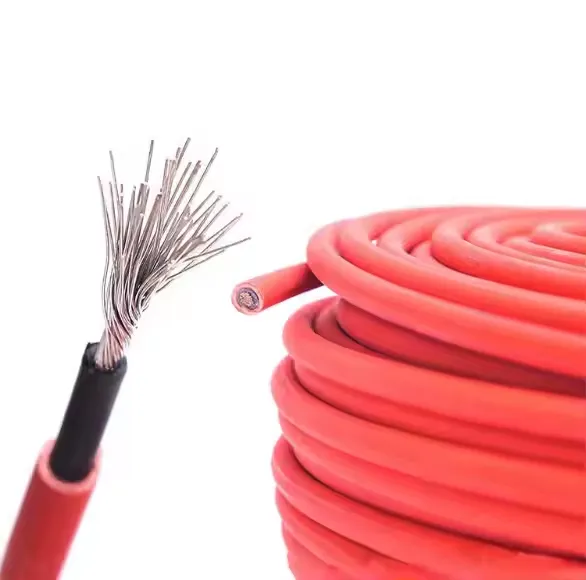Solar Cable Certification Standards: IEC, TUV, CCC Explained
Solar photovoltaic (PV) cables are critical components in PV systems, requiring rigorous certification to ensure safety, performance, and durability in harsh outdoor environments. Certification standards such as IEC, TUV, and CCC provide frameworks for evaluating solar cables’ electrical, mechanical, and environmental properties. This guide explains these standards, their requirements, and their significance for selecting reliable solar cables, presented in a formal and structured manner.

Table of Contents
1. Overview of Solar Cable Certification
Solar cables, typically single-core with tinned copper conductors and XLPE insulation, are designed for DC applications in PV systems, connecting panels to inverters or combiner boxes. Certifications ensure these cables meet stringent requirements for voltage ratings (up to 1.5 kV DC), temperature tolerance (-40°C to 90°C), UV resistance, and flame retardancy. The International Electrotechnical Commission (IEC), Technischer Überwachungsverein (TUV), and China Compulsory Certification (CCC) are key standards ensuring cables perform reliably in diverse environmental conditions for 25–30 years.
2. IEC Standards for Solar Cables
The IEC develops globally recognized standards for electrical equipment, including solar cables. The primary standard for solar PV cables is:
- IEC 62930:
- Purpose: Specifies requirements for single-core, halogen-free cables for fixed and mobile PV installations.
- Voltage Rating: Up to 1.5 kV DC, suitable for modern high-voltage PV systems.
- Temperature Range: -40°C to 90°C, with short-term tolerance up to 120°C.
- Material Requirements: Tinned copper conductors for corrosion resistance and XLPE or similar insulation for UV and chemical resistance.
- Testing: Includes UV aging, thermal endurance, flame retardancy, and mechanical stress tests to ensure durability in outdoor conditions.
- Applications: Used globally in residential, commercial, and utility-scale PV systems, ensuring interoperability and safety.
| Aspect | IEC 62930 Requirements |
|---|---|
| Voltage Rating | Up to 1.5 kV DC |
| Temperature Range | -40°C to 90°C (120°C short-term) |
| Materials | Tinned copper, XLPE insulation |
| Testing | UV, thermal, flame, mechanical |
3. TUV Certification for Solar Cables
TUV is a German certification body that tests and certifies solar cables for performance and safety, widely recognized in Europe and globally.
- TUV Certification (e.g., 2 PfG 1169/08.2007):
- Purpose: Certifies PV cables (e.g., PV1-F type) for reliability in harsh environments, focusing on European market requirements.
- Voltage Rating: Typically 1.0 kV DC, with newer certifications supporting 1.5 kV DC.
- Temperature Range: -40°C to 90°C, with high resistance to UV and ozone.
- Material Requirements: Halogen-free, flame-retardant insulation (e.g., XLPE) and tinned copper conductors to prevent corrosion.
- Testing: Rigorous tests for UV resistance, thermal cycling, water immersion, and mechanical flexibility to ensure a 25-year lifespan.
- Applications: Preferred in Europe, North America, and other markets requiring high-quality assurance, especially for commercial and utility-scale PV systems.
| Aspect | TUV Requirements |
|---|---|
| Voltage Rating | 1.0–1.5 kV DC |
| Temperature Range | -40°C to 90°C |
| Materials | Halogen-free, XLPE, tinned copper |
| Testing | UV, thermal, water, flexibility |
4. CCC Certification for Solar Cables
The China Compulsory Certification (CCC) is mandatory for electrical products sold or used in China, including solar cables.
- CCC Certification:
- Purpose: Ensures solar cables meet China’s safety and quality standards for PV applications.
- Voltage Rating: Typically 1.0 kV DC, with some cables certified for 1.5 kV DC to align with global trends.
- Temperature Range: -40°C to 90°C, suitable for diverse climatic conditions in China.
- Material Requirements: Tinned copper conductors and halogen-free insulation, with a focus on flame retardancy and environmental safety.
- Testing: Includes electrical performance, insulation resistance, flame propagation, and environmental stress tests, tailored to Chinese regulations.
- Applications: Mandatory for PV systems in China, commonly used in residential, commercial, and utility-scale projects within the Chinese market.
| Aspect | CCC Requirements |
|---|---|
| Voltage Rating | 1.0–1.5 kV DC |
| Temperature Range | -40°C to 90°C |
| Materials | Tinned copper, halogen-free insulation |
| Testing | Electrical, flame, environmental |
5. Comparison of Certification Standards
| Feature | IEC 62930 | TUV (2 PfG 1169) | CCC |
|---|---|---|---|
| Voltage Rating | Up to 1.5 kV DC | 1.0–1.5 kV DC | 1.0–1.5 kV DC |
| Temperature Range | -40°C to 90°C | -40°C to 90°C | -40°C to 90°C |
| Geographic Scope | Global | Europe, global | China |
| Key Focus | Global interoperability | High-quality assurance | Chinese market compliance |
| Testing Rigor | Comprehensive (UV, thermal, mechanical) | Rigorous (UV, ozone, flexibility) | Tailored to Chinese regulations |
| Applications | All PV systems | Commercial, utility-scale | Chinese PV projects |
6. Practical Considerations for Selection
When selecting certified solar cables, consider the following:
- Project Location: Choose IEC or TUV-certified cables for global or European projects, and CCC for China-based installations.
- System Voltage: Ensure cables are rated for the system’s maximum DC voltage (e.g., 1.5 kV for modern systems).
- Environmental Conditions: Verify UV, temperature, and moisture resistance through test reports, especially for harsh environments like deserts or coastal areas.
- Supplier Verification: Request certification documents and test reports from suppliers to confirm compliance with IEC, TUV, or CCC standards.
- Cost vs. Quality: TUV-certified cables may be more expensive due to rigorous testing, while CCC cables may be cost-effective for Chinese markets but limited elsewhere.
- Compatibility: Ensure cables are compatible with PV system components (e.g., MC4 connectors) rated for the same voltage and environmental conditions.
7. Conclusion
IEC, TUV, and CCC certifications ensure solar PV cables meet stringent safety, performance, and durability requirements for PV systems. IEC 62930 provides a global standard for interoperability, TUV certification emphasizes high-quality assurance for demanding markets, and CCC ensures compliance in China. By understanding these standards and aligning cable selection with project requirements, environmental conditions, and regional regulations, installers can procure reliable cables that ensure safe and efficient PV system operation for 25–30 years.
Source: JianYunCable.
Comments
Post a Comment